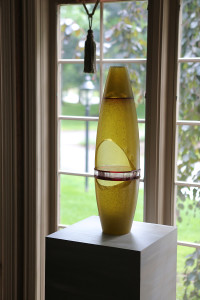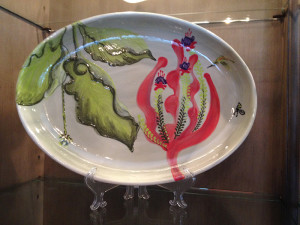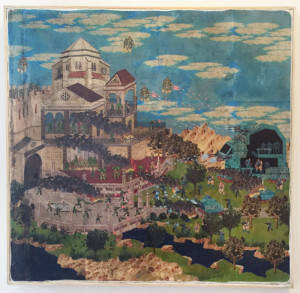Art full presidential residence showcases works by UT faculty, alumni
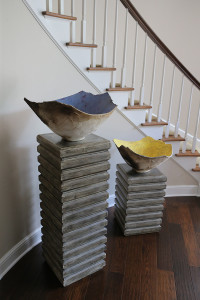
All four works beckon for a closer look.
“Sulphur,” which is yellow, and “Saint-Cyr-su-Mer,” which is blue, were raku-fired by Karen Roderick-Lingeman, senior lecturer in the UT Art Department.
“My travels greatly influence my artwork,” she said. ‘The impressions and stories that inspire my artwork are as much a part of the artwork as the physical piece itself.”
“Transformational Strategy” features beeswax, thread, pearls and Bougainvillea, and “Elemental Connections” was created with found objects by Deb A. Davis, director of the School of Visual and Performing Arts in the College of Arts and Letters.
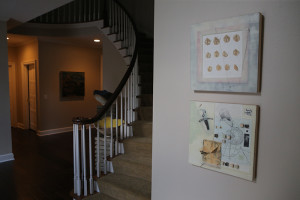
“These are encaustics, or hot wax painting,” Davis said. “For me, working with wax and these disparate items is a puzzle. The puzzle combines the visual approach to creating work, while finding a way to integrate seemingly unrelated items.”
Davis and Barbara WF Miner, UT professor and chair of art, put together “The Presidential Collection: Creating a Visual Presence — Promoting Excellence.”
“This exhibition is about making a mark with the visual arts at UT and promoting the quality of our faculty, students and alumni,” Davis said.
It was Matt Schroeder, UT chief of staff, and Vern Snyder, retired UT vice president for institutional advancement, who suggested showcasing creations by University faculty and alumni.UT President Sharon L. Gaber loved the idea.
“The presidential home is the perfect place to shine a spotlight on creations by artists with UT connections,” Gaber said. “Being surrounded by such an amazing array of work is inspiring. And the art is always a focal point, generating conversations among guests.
“I’m proud to present this collection of fine artwork to everyone who visits the residence.”
A variety of media, techniques and conceptual approaches are seen in the nearly 40 works at the house.

“It is an honor to place artworks in the president’s home, where community dignitaries, donors and alumni are able to see them and, hopefully, mention the caliber of what they saw,” Davis said. “It provides us with a mini-museum setting to express ourselves and impress others.”
“I can tell you that the alumni and faculty whose work is included in ‘The Presidential Collection’ have proudly put that line on their resumés,” Miner added.
“Both the 2D and 3D faculty and alumni pieces look amazing in their locations within the house and add so much dimension and character to the space,” Costell said.
Take Timothy A. Stover’s “Vacant,” for example. Assembled from shards, the amber glass vessel shines in the bay window of the dining room.
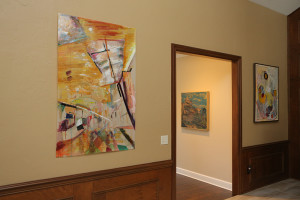
Other eye-catchers in the dining room are delightfully colorful dishes by Julie (Jules) Webster. The delicate pieces are in a lit curio cabinet.
“I often paint what I see out my studio windows, hence the azaleas, hostas, hummingbirds depicted on the pottery,” said the 2007 UT alumna who has participated in the University’s Art on the Mall. “Life can be heavy at times. I hope my work brings each viewer a little moment of simple joy and a feeling of whimsy.”
A playful mixed-media work by Daniel Hernandez, UT assistant professor of art, hangs in the hallway. “Nesaga Mythology” combines religious, mythological and pop culture images, blurring boundaries and questioning iconography and devotion.“My work isn’t intended to be religious or realistically military; it is playing at both of these aspects,” he said. “I like stacking scenes, relating to video game levels and the design of religious artifacts telling stories.”
Much can be read into Miner’s sculptural piece, “gilding the lily one,” which was created from a discarded wedge of wood, 10-karat gold leaf and hundreds of tacks.
“I am fascinated by what we, society, consider precious and what we easily discard,” Miner said. “I like to work at the edge of ideas; how do these materials work together? What does it mean to reclaim materials? How can beauty be retrieved from forgotten objects? Why do we decide that one material, one person, one idea is more valuable than another?
“I try to highlight those considerations in this piece as I adorn and encrust the surface of the wood with embellishment to connote importance and perhaps even reverence for the forgotten.”In the main room, Deborah Orloff’s “Holzwege 16 and 17” offer dreamy locales to disappear into.
“I combine multiple images digitally to create surreal, new spaces where one photograph fades into the next,” the UT professor of art said. “These invented landscapes function as metaphors for the universal experience we all have inevitably, when our lives suddenly change; just when you think you know where you’re going, unexpected circumstances dictate a change of plans.
“Ultimately, the images are meant to be ethereal and optimistic, conveying the sense of wonder that exists when we open ourselves up to new possibilities and realize that change is often fortuitous.”Some new works will be rotated into “The Presidential Collection” in August.
“When I was at an event in the home, a visitor asked me if I knew where the artwork came from, and I very proudly said, ‘This is the artwork of the students, alumni and faculty of UT’s Department of Art. It’s homegrown,’” Davis said.
“We are exceptionally committed artists, scholars, teachers,” Miner said. “Our students benefit from the fact that we have never forgotten that our passion lies in our own creative work.”



